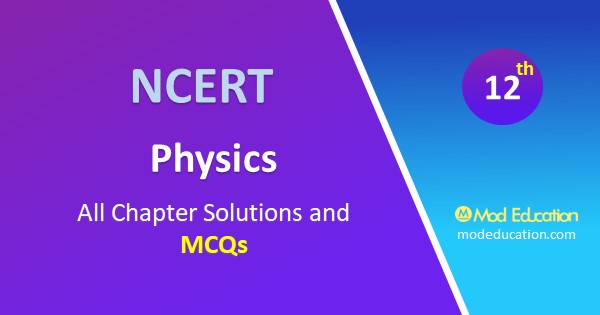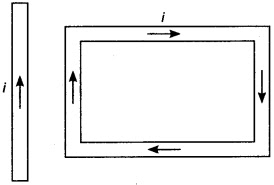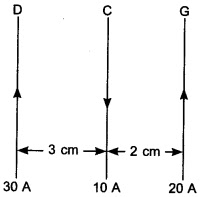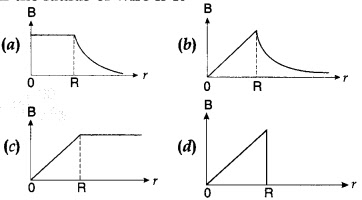MCQ Questions for Class 12 Physics Chapter 4 Download Free PDF: CBSE RBSE and NCERT Physics class 12 MCQs for Chapter 4 “Moving Charges and Magnetism” is very important for the students who want to get good marks. Neet MCQs

MCQ Questions for Class 12 Physics Chapter 4 Moving Charges and Magnetism with PDF
MCQ Questions for Class 12 Physics Chapter 4
Q.1. Biot-Savart law indicates that the moving electrons (velocity v) produce a magnetic field B such that
(a) B ⊥ v.
(b) B || v.
(c) it obeys inverse cube law.
(d) it is along the line joining the electron and point of observation.
Answer: a
Q.2. Two charged particles traverse identical helical paths in a completely opposite sense in a uniform magnetic field B = B0k. [NCERT Exemplar]
(a) They have equal z-components of momenta.
(b) They must have equal charges.
(c) They necessarily represent a particle- antiparticle pair.
(d) The charge to mass ratio satisfy: (e/m)1+(e/m)2=0
Answer: d
Q.3. A circular coil of radius 4 cm and of 20 turns carries a current of 3 amperes. It is placed in a magnetic field of intensity of 0.5 weber/m². The magnetic dipole moment of the coil is
(a) 0.15 ampere-m²
(b) 0.3 ampere-m²
(c) 0.45 ampere-m²
(d) 0.6 ampere-m²
Answer: b
Q.4. The conversion of a moving coil galvanometer into a voltmeter is done by
(a) introducing a resistance of large value in series.
(b) introducing a resistance of small value in parallel.
(c) introducing a resistance of large value in parallel.
(d) introducing a resistance of small value in series.
Answer: a
Q.5. An electron is projected with uniform velocity along the axis of a current carrying long solenoid. Which of the following is true? [NCERT Exemplar]
(a) The electron will be accelerated along the axis.
(b) The electron path will be circular about the axis.
(c) The electron will experience a force at 45° to the axis and hence execute a helical path.
(d) The electron will continue to move with uniform velocity along the axis of the solenoid.
Answer: d
Q.6. In a cyclotron, a charged particle [NCERT Exemplar]
(a) undergoes acceleration all the time.
(b) speeds up between the dees because of the magnetic field.
(c) speeds up in a dee.
(d) slows down within a dee and speeds up between dees.
Answer: a
Q.7. If a charged particle moves through a magnetic field perpendicular to it
(a) both momentum and energy of particle change.
(b) momentum as well as energy are constant.
(c) energy is constant but momentum changes.
(d) momentum is constant but energy changes.
Answer: c
Q.8. A circular current loop of magnetic moment Mis in an arbitrary orientation in an external magnetic field B. The work done to rotate the loop by 30° about an axis perpendicular to its plane is [NCERT Exemplar]
(a) MB
(b) √3MB2
(c) MB2
(d) zero
Answer: d
Q.9. A rectangular loop carrying a current i is situated near a long straight wire such that the wire is parallel to the one of the sides of the loop and is in the plane of the loop. If a steady current I is established in wire as shown in figure, the loop will

(a) rotate about an axis parallel to the wire.
(b) move away from the wire or towards right.
(c) move towards the wire.
(d) remain stationary.
Answer: c
Q.10. A cubical region of space is filled with some uniform electric and magnetic fields. An electron enters the cube across one of its faces with velocity v and a positron enters via opposite face with velocity -v. At this instant,
(a) the electric forces on both the particles cause identical accelerations.
(b) the magnetic forces on both the particles cause equal accelerations.
(c) Only electron gains or looses energy.
(d) the motion of the centre of mass (CM) is determined by E alone.
Answer: b
Q.11. Consider a wire carrying a steady current, I placed in a uniform magnetic field B perpendicular to its length. Consider the charges inside the wire. It is known that magnetic forces do not work. This implies that,
(a) motion of charges inside the conductor is unaffected by B, since they do not absorb energy.
(b) Some charges inside the wire move to the surface as a result of B.
(c) if the wire moves under the influence of B, no work is done by the force.
(d) If the wire moves under the influence of B, no work is done by the electric force on the ions, assumed fixed within the wire.
Answer: b
Q.12. The maximum current that can be measured by a galvanometer of resistance 40 Ω is 10 mA. It is converted into voltmeter that can read upto 50 V. The resistance to be connected in the series with the galvanometer is
(a) 2010 Ω
(b) 4050 Ω
(c) 5040 Ω
(d) 4960 Ω
Answer: d
Q.13. Two identical current carrying coaxial loops, carry current I in an opposite sense. A simple amperian loop passes through both of them once. Calling the loop as C,
(a) ∮CB.dl = ± 2µ0I.
(b) the value of ∮CB.dl is independent of sense of C. c
(c) there may be a point on C where, B and dl are parallel.
(d) B vanishes everywhere on C.
Answer: b
Q.14. The strength of magnetic field at the centre of circular coil is

Answer: c
Q.15. A current carrying closed loop of an irregular shape lying in more than one plane when placed in uniform magnetic field, the force acting on it
(a) will be more in the plane where its larger position is covered.
(b) is zero.
(c) is infinite.
(d) may or may not be zero.
Answer: b
Q.16. A current loop placed in a non-uniform magnetic field experiences
(a) a force of repulsion.
(b) a force of attraction.
(c) a torque but not force.
(d) a force and a torque.
Answer: d
Q.17. If the beams of electrons and protons move parallel to each other in the same direction, then they
(a) attract each other.
(b) repel each other.
(c) no relation.
(d) neither attract nor repel.
Answer: b.
Q.18. A conducting circular loop of radius r carries a constant current i. It is placed in a uniform magnetic field B, such that B is perpendicular to the plane of the loop. The magnetic force acting on the loop is
(a) irB.
(b) 2πriB
(c) zero
(d) πriB
Answer: c
Q.19. The gyro-magnetic ratio of an electron in an H-atom, according to Bohr model, is
(a) independent of which orbit it is in.
(b) neutral
(c) positive
(d) increases with the quantum number n.
Answer: a
Q.20. An electron is projected along the axis of a circular conductor carrying the same current. Electron will experience
(а) a force along the axis.
(б) a force perpendicular to the axis.
(c) a force at an angle of 4° with axis.
(d) no force experienced.
Answer: d
Q.21. Three long, straight parallel wires, carrying current are arranged as shown in the figure. The force experienced by a 25 cm length of wire C is

(a) 10-3 N
(b) 2.5 × 10-3 N
(c) zero
(d) 1.5 × 3 N
Answer: c
Q.22. What is the net force on the rectangular coil?

(a) 25 × 10-7 N towards wire.
(b) 25 × 10-7 N away from wire.
(c) 35 × 10-7 N towards wire.
(d) 35 × 10-7 N away from wire.
Answer: a
Q.23. In a circular coil of radius r, the magnetic field at the centre is proportional to
(a) r²
(b) r
(c) 1r
(d) 1r²
Answer: c
Q.24. A positive charge enters in a magnetic field and travels parallel to but opposite the field. If experiences
(a) an upward force.
(b) a downward force.
(c) an accelerated force.
(d) no force.
Answer: c.
Q.25. When a magnetic compass needle is carried nearby to a straight wire carrying current, then
(I) the straight wire cause a noticeable deflection in the compass needle.
(II) the alignment of the needle is tangential to an imaginary circle with straight wire as its centre and has a plane perpendicular to the wire
(a) (I) is correct
(b) (II) is correct
(c) both (I) and (II) are correct
(d) neither (I) nor (II) is correct
Answer: c
Q.26. A strong magnetic field is applied on a stationary electron. Then the electron
(a) moves in the direction of the field.
(b) remained stationary.
(c) moves perpendicular to the direction of the field.
(d) moves opposite to the direction of the field.
Answer: b
Q.27. In an inertial frame of reference, the magnetic force on a moving charged particle is F Its value in another inertial frame of reference will be
(a) remained same
(b) changed due to change in the amount of charge
(c) changed due to change in velocity of charged particle
(d) changed due to change in field direction
Answer: c
Q.28. Which one of the following is correct statement about magnetic forces?
(a) Magnetic forces always obey Newton’s third law.
(b) Magnetic forces do not obey Newton’s third law.
(c) For very high current, magnetic forces obey Newton’s third law.
(d) Inside low magnetic field, magnetic forces obey Newton’s third law.
Answer: b
Q.29. A charged particle is moving on circular path with velocity v in a uniform magnetic field B, if the velocity of the charged particle is doubled and strength of magnetic field is halved, then radius becomes
(a) 8 times
(b) 4 times
(c) 2 times
(d) 16 times
Answer: b
Q.30. Two a-particles have the ratio of their velocities as 3 : 2 on entering the field. If they move in different circular paths, then the ratio of the radii of their paths is
(a) 2 : 3
(b) 3 : 2
(c) 9 : 4
(d) 4 : 9
Answer: b
Q.31. A charged particle is moving in a cyclotron, what effect on the radius of path of this charged particle will occur when the frequency of the ratio frequency field is doubled?
(a) It will also be doubled.
(b) It will be halved.
(c) It will be increased by four times.
(d) It will remain unchanged.
Answer: d
Q.32. Which of the following is not correct about cyclotron?
(a) It is a machine to accelerate charged particles or ions to high energies.
(b) Cyclotron uses both electric and magnetic fields in combination to increase the energy of charged particles.
(c) The operation of the cyclotron is based on the fact that the time for one revolution of an ion is independent of its speed or radius of its orbit.
(d) The charged particles and ions in cyclotron can move on any arbitrary path.
Answer: d
Q.33. If an electron is moving with velocity ν produces a magnetic field B , then
(a) the direction of field B will be same as the direction of velocity ν.
(b) the direction of field B will be opposite to the direction of velocity ν.
(c) the direction of field B will be perpendicular to the direction of velocity ν.
(d) the direction of field B does not depend upon the direction of velocity ν.
Answer: c
Q.34. Current flows through uniform, square frames as shown in the figure. In which case is the magnetic field at the centre of the frame not zero?

Answer: c
Q.35. A moving coil galvanometer can be converted into an ammeter by
(a) introducing a shunt resistance of large value in series.
(b) introducing a shunt resistance of small value in parallel.
(c) introducing a resistance of small value in series.
(d) introducing a resistance of large value in parallel.
Answer: b
Q.36. Two identical current carrying coaxial loops, carry current I in opposite sense. A simple amperian loop passes through both of them once. Calling the loop as C, then which statement is correct?

(c) there may be a point on C where B and dl are
parallel.
(d) none of these
Answer: b
Q.37. The correct plot of the magnitude of magnetic field B⃗ vs distance r from centre of the wire is, if the radius of wire is R

Answer: b
Q.38. The nature of parallel and anti-parallel currents are
(a) parallel currents repel and antiparallel cur¬rents attract.
(b) parallel currents attract and antiparallel cur-rents repel.
(c) both currents attract. ’
(d) both currents repel.
Answer: b
Q.39. The magnetic moment of a current I carrying circular coil of radius r and number of turns N varies as
(a) 1/r²
(b) 1/r
(c) r
(d) r²
Answer: d
Q.40. Ampere’s circuital law is given by

Answer: b
Q.41. A short bar magnet has a magnetic moment of 0. 65 J T-1, then the magnitude and direction of the magnetic field produced by the magnet at a distance 8 cm from the centre of magnet on the axis is
(a) 2.5 × 10-4 T, along NS direction
(b) 2.5 × 10-4 T along SN direction
(c) 4.5 × 10-4 T, along NS direction
(d) 4.5 × 10-4 T, along SN direction
Answer: b
Q.42. A current carrying loop is placed in a uniform magnetic field. The torque acting on it does not depend upon
(a) area of loop
(b) value of current
(c) magnetic field
(d) None of these
Answer: d
Q.43. In a moving coil galvanometer the deflection (Φ) on the scale by a pointer attached to the spring is

Answer: c
MCQ Questions for Class 12 Physics Chapter wise
mcqs of physics class 12 chapter 4 Moving Charges and Magnetism, mcq of physics class 12 pdf, physics class 12 mcq chapter wise, online mcq test physics class 12 mod education, 12th physics mcq pdf download, physics mcq with answers pdf, mcq questions for class 12 physics chapter 4, mcqs of physics class 12 chapter 4 pdf
